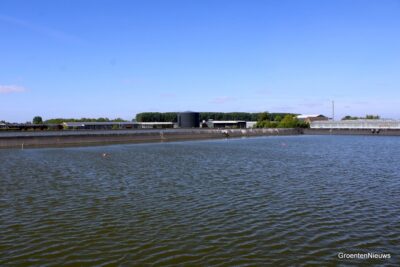High-quality pouring water from large communal water basin benefits Frisian growers in dry season
VEGETABLE NEWS MONDAY, JUNE 2:
Anyone climbing up the communal water basin in Berlikum, Friesland, in mid-May after several months without rain will see calmly rippling water. There is still plenty of water available in the 45,000 m2 basin. A reassurance for growers who do see their individual rainwater basin getting emptier by mid-May.
What also stands out: there are a few orange balls floating in the basin. These help growers keep the water quality right, as they do on their individual farms with Ultramins's USAF™ cavitating ultrasonic emitters.

50 cubic metres per hour
For sweet pepper grower Jaap Vink of Vink Sion, tomato grower Theo van der Kaaij of Kaaij Kwekerij and tomato grower Marco van Overbeek of Gardener's Pride, the presence of the communal water basin in their greenhouse area has long since ceased to be special, even though it is rare elsewhere. The communal basin has been there since the Friesian greenhouse area was set up, in the early 2000s.
The advent of a communal basin was a demand by policymakers. The communal basin became a 'showpiece of sustainability', was good for growers and for the environment, on whom it would have a positive impact. Growers moving into the area had to start using water from the basin. Purchase contracts were concluded for that purpose. Over the years, those individual basins came anyway. After all, you never have enough good irrigation water.
In the greenhouse area, there have been changes at farms since development. Some growers have stopped, or started other activities. Such was the case with Jan and Frans Zeinstra. The former tomato growers no longer use their greenhouses for growing tomatoes, yet together with Vink Sion and Kaaij they still form Kwekerij Gietwater Berlikum. Gardener's Pride is involved in the shared water supply as a buyer.
Originally, the idea was to fill the communal basin with treated surface water, 100 cubic metres per hour. In practice, however, this turned out not to produce the water quality desired by growers. Nowadays, the basin is therefore filled with osmosis water. All users together take 50 cubic metres per hour, to which 30 cubic metres of osmosis water are added per hour. Quick calculation: the basin level is slowly falling. No problem, now that there are fewer users than before, and as long as rain does fall at some point, so the growers can also fall back on the individual basins.
The first channels
The most recent step taken for the community basin to make and keep the water quality even better is installation of USAF™ cavitating ultrasonic transmitters from Ultramins. The Zeinstra brothers were the first in the area to use the transmitters in their own basins. "After installing the USAF™ transmitters in our basins, silos and daily stocks, we noticed significant differences," they revealed after installation. "For the first 2 weeks, slightly more pollution occurred because the transmitters were clearing algae and biofilm. Within 4 weeks, we saw that the water was much clearer and the biofilm and algae had disappeared. The water became much more transparent and cleaner everywhere."
Urgency or prevention
The brothers' experiences were also noted by Frisian colleagues. In mid-May, we make a tour and the three big users of the communal basin come to speak. What immediately stands out is that in this dry year, the role of the communal basin is greater this year than last in the growers' watering strategy.
Spring 2024 was wet, and at least then, pepper grower Jaap needed "almost no" water from the communal water basin. Compared to his colleagues' tomato crops, the water demand from pepper cultivation is more limited. Another factor in this is that he recirculates his water 100 per cent and, thanks to extra screens, less water also evaporates from the greenhouse. "I don't throw away a drop of water," Jaap stresses.
Before Jaap moved to Friesland with his business, he cultivated in a horticultural area between Delf and Rijswijk. The name Vink Sion still refers to this. Here, unlike in Friesland, Jaap only had his own basins. Remarkably, he did not disinfect his basin water back then. "The first years in Friesland I didn't do that either, until it went wrong once. Then we started working with a UV disinfector."
Eric van Velzen, business development manager at Ultramins, recognises the picture. At Ultramins, they see two types of customers, he notes. "Growers for whom investment in our system is urgent due to problems, and growers for whom it's about prevention. Jaap belongs to the latter group."
As for the communal basin, there were complaints. Jaap speaks of 'grey' water. The transmitters of Ultramins have improved the water quality of Pourwater Berlikum.
Allow for more frequent prolonged drought
At Vink Sion, the transmitters float in the water basin totalling 6000m2. Tomato growers in the area, which have been rocked by the rise of Tomato brown rugose fruit virus (ToBRFV) since 2019, all chose to apply the transmitters elsewhere in their watering systems.
Curious about the experiences at its neighbours, tomato grower Kaaij Nursery first put transmitters in its own rainwater basin, and then also in the daily supply silo. The transmitters now float in all basins and in the daily supply silos. Theo: "Only in our waste water silo do we have no transmitters."
For watering the tomato crops, the company combines water from the communal basin and water from its own water resources. Thanks to use of water from Gietwater Berlikum, the tomato growers do not have to completely empty their own basins in a dry spring. "This year, we switched to water from the communal basin as early as March. Last year, we only had to do that much later."
In mid-May, a new 8-hectare greenhouse will be built for Kaaij Nursery, and the water supply will also be expanded again. One of the basins will be made even bigger. That way, the growers will continue to aim for 1,000 cubic metres of water supply per hectare of greenhouse.
"This dry year is one you don't dare write down, but you have to take into account," Theo believes. The ability to also draw water from the communal basin comes in extra handy now. "The trend is that it seems to be getting drier and drier. We need to think about bigger water buffers."
In 2024, Kaaij Nursery started running the USAF™ cavitating ultrasonic transmitters for the first time. Soon the growers saw effects of the transmitters on the hydrogen peroxide they were adding. "We work with a low dose of hydrogen peroxide down to 10 ppm, which was no longer measurable 2 to 3 weeks after the transmitters were installed," he said. Ultramins explained that this was because the transmitter combined with the hydrogen peroxide was breaking down the biofilm, and this proved to be true. The quality of the pouring water now looks good and in terms of hydrogen peroxide we are again measuring the known values. Meanwhile, we can even phase out hydrogen peroxide, because thanks to Ultramins's transmitters, hydrogen peroxide works more effectively."
Cleaner filters
One of Gardener's Pride's sites in the area, a garden the company took over from a colleague eight years ago, relies entirely on water from the communal basin. He welcomes his colleagues' decision to invest in transmitters from Ultramins in the communal basin. "Since using the transmitters, my filters are doing better at the site where we only use water from the common basin. We don't have to backwash them as much because of contamination."
For other tomato grower sites, grower cooperative Oxin Growers invested in USAF™ cavitating ultrasonic transmitters for their member Gardener's Pride, using SIG&F grant funding. Transmitters are now floating in the grower's individual water basins, in the daily supply silos and also in the dirt drain silo.
For the dirt drain silo, the choice fell on the USAF™ MT 600 Watt, the most powerful emitter in Ultramins's range. Eric van Velzen of Ultramins: "A farm's watering on the hottest day determines the capacity needed. That way, we ensure that there is never too little capacity."
Grower Marco is happy with how the transmitters are doing their job for all his Frisian locations. "Thanks to the investment Oxin Growers made for us, the UV disinfector is now running more stably. The T10 values are better." Applying the transmitters in several places in his watering systems means there is double water treatment in several places. "I wouldn't know what else to do here now," he says.
USAF™ MT 600 Watt, the most powerful transmitter in Ultramins's range, in silo at Gardener's Pride
Frisian growers set a good example
Ultramins now supplies USAF™ cavitating ultrasonic transmitters in more than 50 countries. Still Eric continues to be amazed that water is underestimated. "Water goes through your greenhouse like a train, calling at every little station. In horticulture, we spend a lot of time above ground, but special attention is also needed for what happens underground."
The growers in Berlikum are well aware of the importance of good pouring water and have made joint and individual efforts to improve water quality. The quality of the pouring water from the communal basin is to the satisfaction of the growers, the filters remain clean and all the water is clear, observed Theo and Eric after double-checking with a bottle sample.
Having the sediment removed from the bottom once in a while is advisable, Eric advises. Should the common basin really run dry this year due to extreme drought, this is the perfect opportunity to do so. But growers would rather keep the basin filled, and their pouring water clean. And with the help of the USAF™ cavitating ultrasonic emitters, this has worked out well. Pressure from algae, biofilm and pathogens in the water are a thing of the past.
USAF™ is a trademark of Luijkx Ultrasound B.V.
For more information:
Ultramins B.V.
+31(0) 85 023 10 97
info@ultramins.com
www.ultramins.com
Also read the article at:

